I tried Example 1b of https://apmonitor.com/do/index.php/Main/DynamicOptimizationBenchmarks.
I construct two different form of the same terminal conditions as follows:
import numpy as np
import matplotlib.pyplot as plt
from gekko import GEKKO
m = GEKKO()
nt = 101
m.time = np.linspace(0,2,nt)
# Variables
x1 = m.Var(value=1)
x2 = m.Var(value=0)
u = m.Var(value=-0.48)
p = np.zeros(nt)
p[-1] = 1.0
final = m.Param(value=p)
# Equations
m.Equation(x1.dt()==u)
m.Equation(x2.dt()==x1**2 + u**2)
# terminal conditions
m.Equation(final*(x1-1)==0) # 1st form
# m.fix_final(x1,val=1) # 2nd form
m.Obj(x2*final)
m.options.IMODE = 6
m.solve()
plt.figure(1)
plt.plot(m.time,x1.value,'k:',linewidth=2,label=r'$x_1$')
plt.plot(m.time,x2.value,'b-',linewidth=2,label=r'$x_2$')
plt.plot(m.time,u.value,'r--',linewidth=2,label=r'$u$')
plt.legend(loc='best')plt.xlabel('Time')plt.ylabel('Value')plt.show()
They behave differently and achieved different solutions as follows.
1st form m.Equation(final*(x1-1)==0):
2nd form m.fix_final(x1,val=1):
I prefer to use fix_final to define such a terminal constraint like x(tf)=0. But it seems to make the problem unsolvable. Like the 13rd problem in https://apmonitor.com/wiki/index.php/Main/GekkoPythonOptimization.
from gekko import GEKKO
import numpy as np
import matplotlib.pyplot as plt
m = GEKKO() # initialize GEKKO
nt = 501
m.time = np.linspace(0,1,nt)
x1 = m.Var(value=np.pi/2.0)
x2 = m.Var(value=4.0)
x3 = m.Var(value=0.0)
p = np.zeros(nt) # final time = 1
p[-1] = 1.0
final = m.Param(value=p)
tf = m.FV(value=1.0,lb=0.1,ub=100.0)
tf.STATUS = 1
u = m.MV(value=0,lb=-2,ub=2)
u.STATUS = 1
m.Equation(x1.dt()==u*tf)
m.Equation(x2.dt()==m.cos(x1)*tf)
m.Equation(x3.dt()==m.sin(x1)*tf)
# terminal constraints
m.Equation(x2*final<=0) # get solution
m.Equation(x3*final<=0)
# or
# m.fix(x2, pos=len(m.time)-1,val=0) # solution not found
# m.fix(x3, pos=len(m.time)-1,val=0)
# or
# m.fix_final(x2,val=0) # solution not found
# m.fix_final(x3,val=0)
m.Obj(tf)
m.options.IMODE = 6
m.solve()
plt.figure(1)
plt.plot(tm,x1.value,'k-',label=r'$x_1$')
plt.plot(tm,x2.value,'b-',label=r'$x_2$')
plt.plot(tm,x3.value,'g--',label=r'$x_3$')
plt.plot(tm,u.value,'r--',label=r'$u$')plt.legend(loc='best')plt.xlabel('Time')plt.show()

